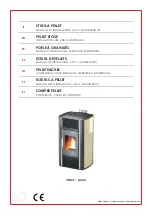
6.3.2
Reload with fuel
Caution:
If there is insufficient burning material in the firebed to light a new fuel
charge, excessive smoke emission can occur. Refueling must be done onto a
sufficient quantity of glowing embers and ash to make sure that the new fuel
charge will ignite in a reasonable period. If there are too few embers in the fire
bed, add suitable kindling to prevent excessive smoke.
Note:
The procedure hereunder is a general description. The best reloading
moment is dependent on the flue draught. A high flue draught requires
reloading when the flames have completely disappeared. If the flue draught is
low, reloading must be done when there are still flames.
1. Wait until the last flames have almost disappeared.
2. Set the control lever in the far right position.
3. Open the door.
4. Reload the appliance with the
recommended amount of fuel. Refer
to section
5. Close the door.
6. After ignition of the fuel, move the
control lever to a position that gives a
quiet burning fire.
6.3.3
Control the burn process
Control the burn process with the control lever. This lever controls the amount of primary
combustion air and both the secondary combustion air and airwash amount.
Warning:
Setting the control lever in the far left position (all air inlets closed) when the
fuel is burning leads to excessive emission of hazardous gasses (example:
carbon monoxide) and soot deposit on the glass of the door and in the
chimney. Never close the air inlets when the fuel is burning. Always keep
the secondary air inlet and air wash inlet open by setting the control lever
somewhere in-between the center position and the far left position.
Caution:
Continuous firing with the primary air inlet fully open (control lever in the far
right position) causes a white-hot fire that can damage the appliance. Use the
primary air only during the first fuel load and for ignition of a new fuel load.
Operation
BOX 30 75
15














































